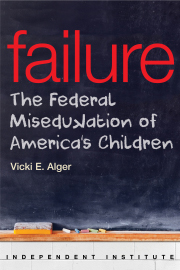Viewers nationwide tuned in to Fox News’ recent debate between two governors who are not political rivals but whose views on education couldn’t be more divided.
At the heart of the divide between Florida Gov. and GOP presidential candidate Ron DeSantis and California Gov. Gavin Newsom is who they—and their respective states—recognize as the real education experts: parents or government.
While Newsom touted a provision in the California Constitution guaranteeing parents’ ability “to participate in the educational process,” the reality is that the state is the ultimate arbiter of how, where, and what children are taught in school. In stark contrast, DeSantis signed the Parental Rights in Education bill into law last year, affirming parents’ fundamental right to direct the education and upbringing of their children.
This bill is hardly an isolated example of parent empowerment. Over the past 25 years, Florida has implemented a growing number of educational choice programs.
Unlike California, where schooling is primarily rationed based on where families can afford to live, Florida offers parents some of the country’s most expansive non-public education options through four tax-credit scholarship and education savings account (ESA) choice programs, which enroll nearly 200,000 students combined.
Today, Florida’s fourth graders rank in the top four nationally for math and reading performance on the National Assessment of Educational Progress (NAEP), also known as the Nation’s Report Card. Meanwhile, California’s fourth-grade performance ranks near the bottom.
Not so long ago, Florida’s student performance wasn’t much better than California’s. In fact, by the late 1990s, Florida public schools also ranked near the bottom on most national surveys, and around half of all Florida’s fourth graders were functionally illiterate. Then, in 1998, Florida enacted sweeping accountability reforms, including educational choice programs, that put parents in charge. Since then, students from the Sunshine State have been outperforming their Golden State peers across the socioeconomic and demographic spectrum.
Fourth-grade NAEP results are a case in point. Experts tend to focus on these results because if students have not mastered the fundamentals by fourth grade, especially in reading, they tend to fall further behind in subsequent years, increasing the likelihood that they will drop out.
In every NAEP fourth-grade math and reading assessment since 2003, Florida’s Black, Hispanic, low-income, and English-learner students have outperformed their California peers in math and reading. Even more impressive is the fact that Florida’s Hispanic fourth graders have outperformed all California fourth graders in math and reading since 2003, and they have performed as well or better than all U.S. fourth graders since 2013. Similarly, low-income Florida fourth graders have outperformed all California fourth graders in most years since 2003 in math and reading, and today they are within two math and three reading NAEP scale score points of matching the performance of all U.S. fourth graders.
Closing achievement racial gaps is another area where Florida outshines California. Between 2003 and 2019, before COVID-related school policies went into effect, Florida’s Black/White fourth-grade achievement gap shrank by seven NAEP scale score points in math and nine points in reading. California’s Black/White fourth-grade math gap shrank about half as much as Florida’s over the same period, while its reading gap grew by five points.
Student demographics have little, if anything, to do with Florida’s superior performance. Both California and Florida have similar proportions of low-income students who are eligible for free and reduced-priced lunches, 58 percent and 54 percent, respectively. California has a larger population of Hispanic students than Florida, 56 percent compared to 36 percent, but Florida has a much larger population of Black students than California, 21 percent compared to 5 percent. And, contrary to conventional wisdom, Florida spends $4,500 less per pupil than California, $11,700 compared to $16,200, and still achieves superior student achievement.
As we head into another election year, the real education debate is not about blue versus red or this versus that party. It is about who knows best. Florida proves that putting parents in charge of their children’s education works. Meanwhile, California clings to a government-run, one-size-fits-all schooling model that’s proving to be an ineffective relic of a bygone era.









